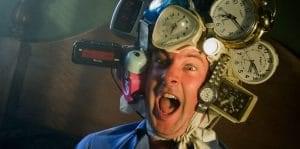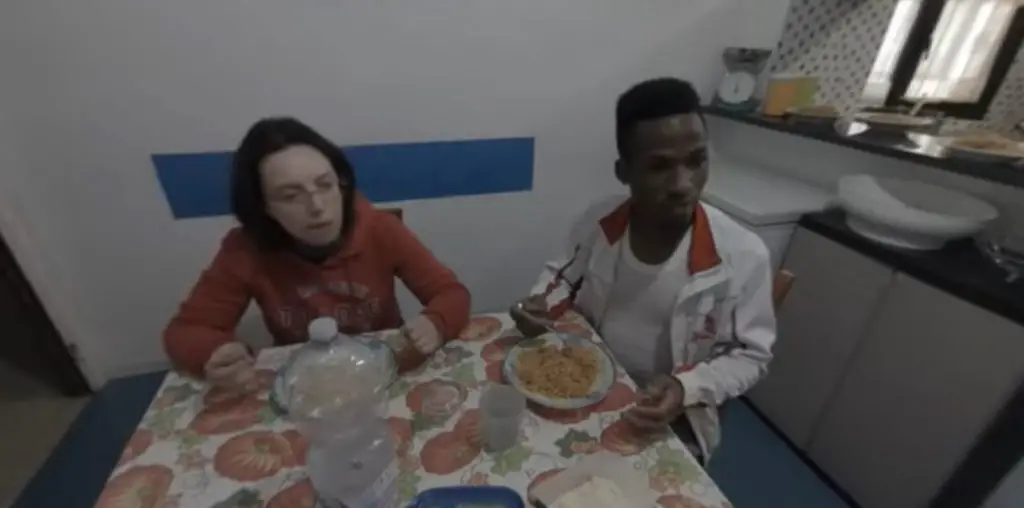
Syndrome, the antagonist from Pixar’s masterpiece The Incredibles, rationalizes his behavior and general scheming with one succulent phrase- “And when everyone’s super, no one will be.” This quote popped into my head during the first 10-minutes of the surreal descent into madness that is Saint Bernard, but with a slight variation—when everything is off-the-wall weird than nothing is.
From a young age, Bernard (Jason Dugre) has had an affinity for music. As he grows up, he is ushered by his family to nurture his gifts. So, Bernard becomes a composer. One day during a performance, Bernard flubs it up entirely. He runs away, and while speeding down the interstate, he discovers a massive, severed Saint Bernard’s head. He wraps the dog’s head in a burlap sack and starts carrying it everywhere he goes; even to church.
After leaving the concert, Bernard essentially enters his own version of Wonderland. Wandering about the city, he meets Miss Roadkill (Katy Sullivan), who wears roadkill animals over her clothes, and the enigmatic Othello (Warwick Davis). He also bumps into unsavory and angry people.
So that is the movie in a nutshell. Bernard goes from one whacked out scene to the next, all without any context or sense of reality. In fairness to writer-director Gabriel Bartalos, his intentions with Saint Bernard seem to be to replicate the point of view of the unstable main character. There is absolutely nothing wrong with using the art and production design, along with the lighting and cinematography to get into the headspace of any given role. In fact, I’d argued such an approach is much more beneficial than a journeyman, point-and-shoot way of working.

“…Bernard flubs it up entirely. He runs away, and while speeding down the interstate, he discovers a massive, severed Saint Bernard’s head.”
The issue is that even the supposed real world sequences are bizarre as hell. Even fantasy movies that take place in wholly original worlds ground themselves in some form of reality, as to not distance the audience. There is no such baseline present in Saint Bernard, so there are no stakes. Anything can happen without an explanation at all, so the viewer is lost and confused. It is true that in Lewis Carroll’s famed story Alice In Wonderland, similar random encounters happen while Alice is there. However, there’s a sizable difference in the execution of the two titles. Alice is from a recognizable, tangible world; ostensibly the regular, present day for when the book was written. She reacts and behaves in a fashion that the reader (or viewer of any of the various movie versions) can understand and relate to.
Here, Bernard looks about as confused as the audience the entire time. The reason there aren’t more details laid out for how Bernard messes up as he is conducting that concert is that I am not sure what happens. Based on the imagery throughout, it probably has to do with drug and alcohol addiction. However, the movie just jumps through any possible reason, tragedy, or arc that would send him down such a path. Thus, the audience is only left with a hint, big though it is, that addiction is Bernard’s problem. Without understanding his career and life before he slides into addiction (presuming that is meant to be one of the issues here; admittedly not a huge leap but still may not be 100% accurate) there is no reason to care that he makes it to the end of his journey.
Frustratingly, any semblance of the real world is undone before the adventure really begins. Around 10-minutes in is an odd montage of Bernard sleeping with a helmet made of dozens of alarm clocks. Bernard also wears a full-on aluminum suit, and then he sticks a tuning fork into an electrical outlet. Plus, while he’s at a music store, he’s oddly stringing something together. All of this is before the concert he escapes from; which it should be noted, that at one point for no reason while getting to his car, he morphs into a head with a worm-like body. This is what I mean when I cite a lack of reality. Be as fantastically odd and visually creative as you want, but the audience needs a way to enter the world being presented. Without that, they will not understand, thus not care, about the characters or story.

“…the audience needs a way to enter the world being presented.”
There is no access point throughout the entire production of Saint Bernard. The kicker of which the direction is pretty good. Gabriel Bartalos has a keen eye for epic, striking visuals. Bernard finds himself locked in an odd cell with various wires and such hanging all around. As the camera tracks through the large hall, to the cell, Bernard is just left of center, and he is wearing a device that gives him the appearance of three heads. He screams. It is a cool looking moment.
The costumes, especially for Miss Roadkill, are fantastic, well-detailed creations. The editing is a bit chaotic at times, which actually helps with the crazed, frenzied landscape of the movie. Frustratingly, the acting isn’t as engaging. Dugre as Bernard barely registers onscreen. He comes across as meek and awkward, which certainly does not help with the screenplay’s failure at characterization and world building.
Intriguingly enough, he is surrounded by a phenomenal supporting cast. Katy Sullivan fully commits to the eccentric Miss Roadkill, and she brings a liveliness that is sorely missed when she is not onscreen. Warwick Davis gets to be creepy and mysterious, and it makes me realize how underappreciated he is as an actor. He sells the ridiculousness with gumption, and his scene is one of the few times in the film that there is a real sense of danger and awe.
Saint Bernard is weird for the sake of being weird. There is a specific audience that will revel in that oddity and enjoy the movie strictly on those terms. However, as a film with characters and a story to tell the film falls far short of its goals, in part because the lead actor is miscast. This isn’t a terrible movie, but it isn’t very good either.

Saint Bernard (2019) Directed by Gabriel Bartalos. Written by Gabriel Bartalos. Starring Jason Dugre, Katy Sullivan, Warwick Davis, Peter Iasillo Jr., Bob Zmuda, George Clayton Johnson.
5 out of 10 Rabbit Holes

